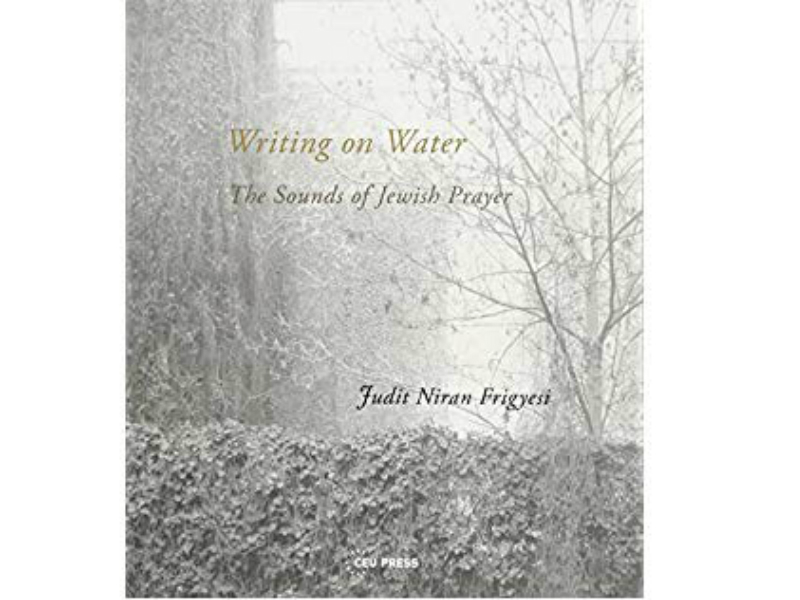Though she lives in Israel and is a musicologist at two universities there, Judit Niran Frigyesi’s professional and personal commitments are in Hungary, especially among the Jews of Budapest.
There, starting in 1976, she recorded the repertoire of prayer leaders in the city’s semi-secret shuls and study houses. Her biography points to the singularity of this work. Her personal research archive contains “the largest integral collection of the east-European Jewish liturgical service and the largest archive of the music of the Hungarian Jews.” She describes herself as “the only scholar to systematically research traditional Jewish music in Communist Europe after the Holocaust.”
Frigyesi’s Writing on Water: The Sounds of Jewish Prayer does not read like an academic work, but a highly poetic memoir of her decades of dedication to preserving and appreciating the musical lives of Hungarian Jews. Published by the beleaguered Budapest-based Central European University, it is itself a beautiful thing, illustrated by Frigyesi’s haunting black and white photographs. Writing on Water is a meditation on lost culture, on the meaning of music in our lives, and on the unique predicaments of postwar Jewish life in central and eastern Europe.
Music, for many people, is a source of joy and interest that is not connected to deeper study or comprehension. Jewish prayer, in our contemporary age, falls into a category of deeper mystery – its resources and mode of expression are removed in many ways from contemporary lives.
Frigyesi began her musical training conventionally, at the Franz List Academy in Budapest. But in her 20s she was drawn to explore Jewish music and prayer at a time when the Hungarian Communist authorities forced such activities, for the most part, underground.
Many of the men and women she interviewed and recorded were survivors of the wartime and had drastic stories to tell. These stories are muted in Writing on Water. But in some of her interviews her informant describes memories from before the war of Hungarian small-town life – often of intense rural poverty – and the impact of it on Jewish music.
One of Frigyesi’s interviewees speaks at length about the prewar competition among composers who presented their work to Hasidic rebbes in the hope that it might become part of a rebbe’s court repertoire.
Frigyesi returns again and again in her interviews and meditations to what she considers to be key elements of traditional Jewish prayer: davenen (davening), nisech (nusach) and kavunes (kavanut). Among these, nisech is the most straightforward and easily comprehended. It can be defined as a “traditional melody.” Davenen encompasses a much broader set of habits of prayer, modes of comportment while singing, and is more difficult to define. Frigyesi asserts that “the secret of davenen” is revealed in such things as “the colour of voices and in their fluctuation,” the way they create “waves” of sound in elusive “measures and beats.”
The notion of kavunes, for the secular-minded, presents its own challenge to apprehension and appreciation. When one of Frigyesi’s informants struggles to convey his approach to chazunes (hazzanut) – to his role leading prayer – he insists: “We never spoke about dates and melody and origin. Only one thing mattered: devotion, kavvanah, kavunes. The kavunes brought out the melody.”
This is abstract, but another aging baal tefilah of a dwindling Budapest prayer community puts things another way, not unlike the way a free jazz saxophonist of the 1960s might: “I daven differently every time. . . . prayer is not enjoyment. It is kavunes. What matters is the intensity with which you live through the words.”
The intensity with which you live through words might describe a wide range of writerly and creative work. Frigyesi herself follows this goal in her approach to her material in Writing on Water. It is this approach that sets her book apart from a typical scholarly or ethnographic work that no one but a specialist would read. She is deeply committed to the people she came to know through her interviews, and to the musical and religious culture she portrays, even if she is not herself a vocalist or a person of deep faith.
READ: WHEN THE NOBEL TAKES A HOLIDAY
Upon returning to Budapest after the fall of Communism, Frigyesi was struck by how much of what she’d known of the old postwar city had evaporated. Many of her informants were gone. And a new religious model had taken hold, following American and modern Orthodox forms of prayer and leadership.
Her view of these changes is revealing and worth a careful hearing: “I often ask myself why I feel so uncomfortable during the zmires (zemirot) sessions of modern Orthodox Jews, and why I felt relaxed hearing those old men in Budapest in the ‘70s, even though the sloppiness of their singing puzzled me. . . . I am unable to take seriously anything that projects cloudless optimism, unshaken belief, or confident know-how without so much as a hint of self-irony. Those young men around their Shabbat table did not realize how close the forced happiness of their zmires came to my experiences of Communist singing contests.”
Frigyesi’s work at recovering song and prayer has a wistful character, and conveys irreparable loss in the wake of the war and the Communist era in Hungary. She describes her visits to near-abandoned synagogues, where she sneaks a look at upper balconies and hidden study rooms that are no longer used. Yet her portrait of changing Jewish life in central Europe is so richly conveyed that it feels like a gift, a discovery of things unappreciated and unseen.
